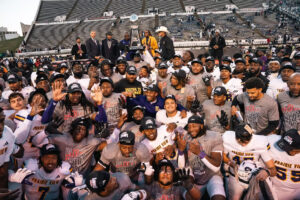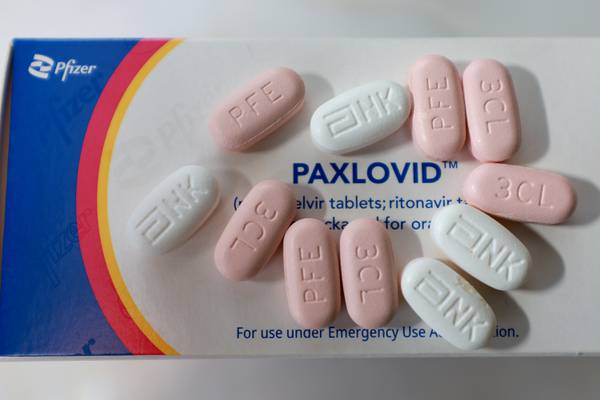When Marnie Monogue developed a tickle in her throat last week, COVID-19 was the last thing on her mind.
”I had been feeling sick and awful all day Saturday,” said Monogue, 24, who lives in Uptown and works in marketing for a nonprofit. “I kept thinking, ‘Oh, it’s just sinus pressure from changes in the weather.’”
Monogue took two at-home COVID-19 tests Saturday night. Both were positive. Monogue suspects she caught the virus during a recent trip to see the “Barbie” and “Oppenheimer” movies as a double feature.
“I had heard that there was going to be a summer surge, but it caught me by surprise,” she said.
She’s among an increasing number of Chicago residents who’ve been unexpectedly hit with COVID-19 in recent weeks. The numbers of COVID-19 cases and hospitalizations in the Chicago area have been slowly creeping upward as summer winds down, following a national trend and reminding people that COVID-19 is still lurking, even if it’s no longer top-of-mind.
In Chicago, laboratory-confirmed cases of COVID-19 were up 27%, to 67 new cases a day, on average, as of July 28, compared with the previous week, according to the Chicago Department of Public Health.
Only 4.3 Chicago residents were newly hospitalized with COVID-19 each day on average, as of July 22. But that was an increase of 43% over the prior week. In Cook County, hospitalizations increased by 13.6% percent, to 100 new patients for the week ending July 22, compared with the previous week, according to the Centers for Disease Control and Prevention.
Nationally, hospitalizations for COVID-19 were up 12.1% for that same week.
Local health leaders, however, say there’s no need to panic. Overall COVID-19 case numbers and hospitalizations remain low.
COVID-19 in Chicago is still “broadly under great control,” said Massimo Pacilli, deputy commissioner for disease control at the Chicago Department of Public Health.
Doctors don’t necessarily expect this latest bump to turn into a major surge. That’s partly because so many people have antibodies to fight COVID-19, thanks to vaccinations and previous bouts with the illness. It’s also because omicron variants and subvariants are still the main circulating strains — rather than new, more threatening strains, Pacilli said.
“Absent some dramatic shift in the type of virus circulating, we don’t expect for it to have the same impact of stretching the system as when omicron first came on the scene,” Pacilli said.
It’s not surprising that numbers are rising slightly, said Dr. Mia Taormina, chair of the department of infectious disease at Duly Health and Care. She said she noticed more patients hospitalized with COVID-19 in recent weeks, often people who are elderly or immunocompromised.
“We couldn’t be at historic lows forever,” Taormina said. “It’s bound to pick up a little bit, but I think we’re in good shape still.”
She anticipates that numbers may continue to rise, as children go back to school in the coming weeks and the weather cools. But she doesn’t expect a wave of the illness anywhere near as large as the ones that flooded hospitals in previous years. Across the U.S., there were about 8,000 new hospitalizations for the week that ended July 22. At this time last year, that number was more than 40,000.
“Yes, we’re going to see numbers coming up. We’re going to see hospitalizations come up, we’re going to see emergency room and immediate care visits come up,” she said. “But it’s still not going to be to the magnitude of what we saw a year ago, unless we have something strange happen.”
Some local doctors say they’ve noticed the uptick while others say they have yet to see it.
In recent months, it wasn’t unusual for Dr. Sindhu Aderson to go an entire shift at an immediate care clinic without seeing any patients with COVID-19. During one shift this week, there were four COVID-19 positive patients.
“I had gone weeks without seeing any,” said Aderson, who is the central region medical director of Northwestern Medicine Immediate Care Centers. But, she said, “At this point I’m not terribly concerned, given a good proportion of our population is vaccinated and we do have Paxlovid in our back pocket.”
Paxlovid is an antiviral treatment for people with mild to moderate cases of COVID-19 who are at high risk of developing severe illness.
Rush University Medical Center, however, hasn’t had many more hospitalizations for COVID-19 lately, said Dr. John Segreti, hospital epidemiologist at Rush University Medical Center.
He noted, however, that hospitalizations often lag behind increases in cases. It can take time for a person with COVID-19 to get sick enough to go to the hospital.
It can also be difficult to tell from publicly available data how widespread the illness is. “Data collection isn’t nearly as complete as it used to be,” he said. The Centers for Disease Control and Prevention is also monitoring wastewater for the virus that causes COVID-19, but those results seem to be a mixed bag for the Chicago area, with some sites showing increasing levels and others decreasing levels from July 17 to July 31.
Many COVID-19 cases are also likely going unreported because so many people test for COVID-19 at home when they feel ill, or they don’t test at all.
Segreti said he wouldn’t be surprised if COVID-19 spreads more once kids go back to school, but he also doesn’t think it’s a certainty.
Doctors will, however, be watching cases and hospitalizations as the cold weather sets in, and the start of the traditional respiratory illness season begins. Last fall, cases of RSV, which stands for respiratory syncytial virus, stretched children’s hospitals in Illinois and across the country. Increases in RSV often coincide with flu season and a jump in other respiratory illnesses.
“It’s going to be very similar to last fall where it’s going to be like whack-a-mole: Is it flu? Is it COVID? Is it RSV?,” Taormina said of what patients may experience in coming months.
Physicians hope new RSV vaccines for infants and older adults, and new boosters expected for COVID-19 will help blunt any surges.
In the meantime, doctors say Illinois residents should be aware of the uptick in COVID-19, and take commonsense precautions if they feel ill, such as staying home.
People should get vaccinated if they haven’t done so, doctors say. Those who are high risk of severe COVID-19 should consider whether to mask in public places, and should see if they are candidates for Paxlovid if they catch COVID-19, Segreti said.
“At this point, I think it’s very important that people realize that COVID did not go away,” he said. “It’s been with us, albeit at very low levels and people can still catch COVID, and if you do get sick, you should test yourself or get tested and avoid being around other people.”







